Lifting heavy, eating well, and recovery strategies are all part of the big picture of making gains. When it comes to recovery, there are many options to explore. In addition to getting adequate sleep, you may prefer mobility work, myofascial release, stretching, or exposure to extreme temperatures.
Using a sauna or taking a cold plunge are both forms of hormetic stress. It is “good” stress, like exercise, that has health benefits as your body adapts. Saunas and cold plunges are popular with strength athletes because they can maximize muscle recovery by increasing blood flow. Sauna use and the cold plunge may also benefit cardiovascular, immune, and mental health.
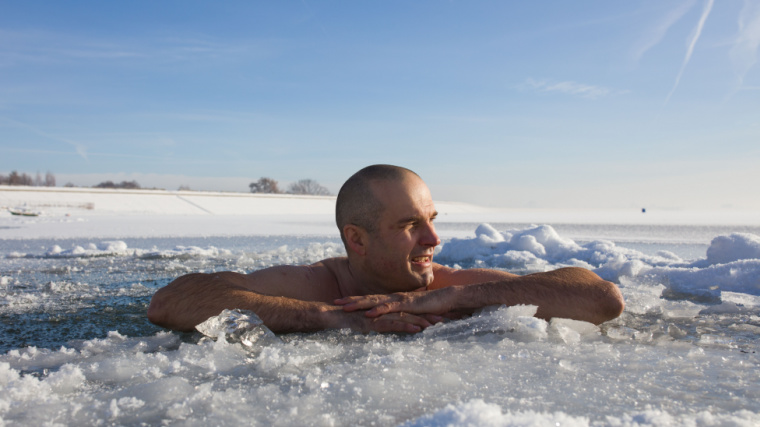
Here, we’ll explain the cold plunge versus sauna and how to use each. We’ll also detail the differences and how they may produce similar health benefits, although they affect your blood vessels differently. Ready to jump into cold water or hang out in the heat? Here we go.
- What Is a Sauna?
- What Is a Cold Plunge?
- Differences Between the Sauna and Cold Plunge
- How to Use the Cold Plunge
- How to Use the Sauna
- Frequently Asked Questions
What Is a Sauna?
Sauna, a Finnish word, is a room with wood benches and paneling where you sit and undergo heat exposure. Original saunas used wood fires to heat the air. Nowadays, traditional saunas use a conventional electric heater, and infrared saunas use infrared light. (1)
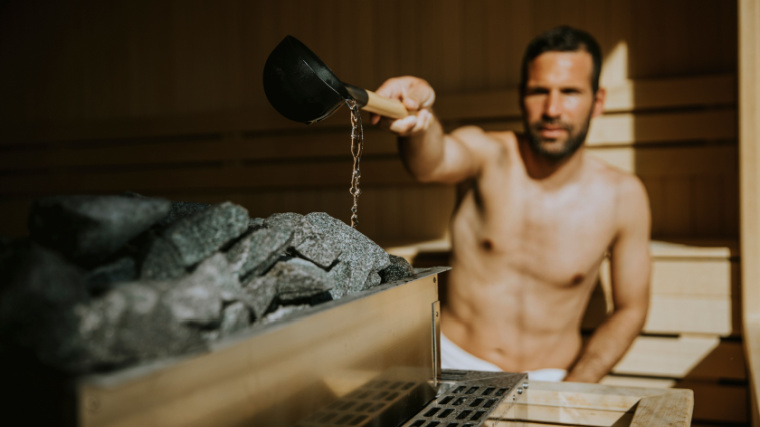
[Read More: Why Saunas Can Build Muscle, Boost Endurance, and Increase Strength]
Across the world, for thousands of years, people have been practicing “sauna bathing.” Sauna bathing refers to exposing yourself to high temperatures to experience healing and cleansing. (1)
Types of Saunas
The two main types of saunas are traditional saunas and infrared saunas. In a traditional sauna, a heater warms the air to 70 to 100 degrees Celcius (158 to 212 degrees Fahrenheit), with about 10 to 20 percent humidity. You stay in for five to 20 minutes. (1)
In infrared saunas, infrared light heats your skin directly to raise your core body temperature. The temperature is cooler than a traditional sauna. It ranges from 40 to 60 degrees Celcius (104 to 140 degrees Fahrenheit), and you stay for 15 to 30 minutes. (2)
In both sauna types, your core body temperature rises and your sweat glands activate. Your heart rate, cardiac output, and blood circulation increase. Vasodilation, or the relaxing and dilation of your blood vessels, also improves, leading to increased blood flow. These physiological effects are similar to your body’s response to moderate exercise. (2)
Benefits of the Sauna
Like exercise, sauna use puts your body under hormetic stress. Repeated heat exposure in sauna sessions increases heat shock proteins. Your body adapts and can better tolerate heat and gets better at regulating your body temperature. (2)
This process and increased blood flow lead to further potential health benefits: improved muscle recovery, better cardiovascular health, higher energy levels, and enhanced overall wellness.
May Improve Muscle Recovery
After resistance training, relaxing in the sauna may help strength athletes get a jump start on muscle recovery.
Sauna use increases blood flow and circulation, which may help reduce muscle soreness. Improved circulation helps deliver nutrients and oxygen to your muscles, which may reduce inflammation. (2)
[Read More: 10 Benefits of a Sauna After a Workout That Will Revolutionize Your Recovery Strategy]
One study investigated whether far-infrared sauna use could improve muscle recovery for cis men doing strength and endurance training. The study concluded sauna bathing helped their neuromuscular systems recover better from maximal endurance training. (2)
Another study was done on cis male basketball players. After resistance training, they used the infrared sauna. The day after training, the study found they had better recovery of explosive power capacity and decreased muscle soreness. (3)
May Boost Cardiovascular Health
Regular sauna use may strengthen your cardiovascular health, lower your blood pressure, and protect your heart health. Studies on Waon therapy, a type of infrared sauna use, particularly suggest this. (2)
In a study on people with high blood pressure, infrared sauna therapy lowered their blood pressure. Researchers believe it’s because sauna use relaxes blood vessels through vasodilation, which lowers blood pressure. The study also states that sauna use may help fight oxidative stress, lowering people’s risk of cardiovascular diseases. (4)
An additional study found that regular sauna use was associated with a reduced risk of cardiovascular diseases and all-cause mortality. (5)
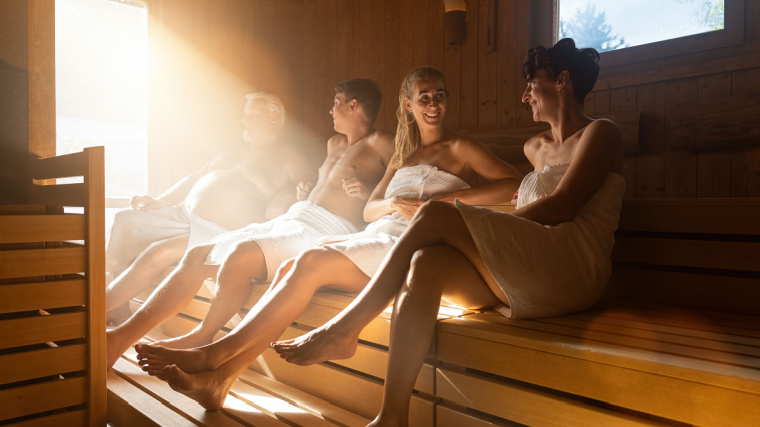
[Read More: How Long Should You Stay in a Sauna?]
A systematic review of the clinical effects of sauna bathing found that increased sweating and heat shock proteins had cardiovascular and metabolic benefits. Infrared sauna use was helpful for people with cardiovascular diseases and heart failure. (6)
The review states that sauna use alone may not improve cardiovascular health. People using saunas may be more likely to exercise and engage in healthy habits. Sauna use may still be a great addition to improving cardiovascular health. (6)
May Increase Energy Levels
Regular sauna use may help improve energy levels. A study was done on people with chronic fatigue syndrome. They did Waon therapy five times a week for four weeks. After the treatment, they reported reduced feelings of fatigue. They also had reduced depression and anxiety symptoms, with an increased positive mood. (7)
Sauna use may also increase energy levels for strength athletes, helping them get back to their next session energized and ready to go.
May Improve Well-Being
Relaxing in the sauna can contribute to general well-being and boost overall wellness. Heat exposure is a form of good stress that can help relieve chronic stress. Practicing breathwork, meditation, or simply sitting still in the sauna can calm your nervous system. Doing it after a workout also helps your body relax and return to homeostasis.
Less stress is key to overall health.
What Is a Cold Plunge?
A cold plunge, also known as an ice bath or cold water immersion, refers to immersing yourself in 10 to 15 degrees Celcius (or 50 to 60 degrees Fahrenheit) water for five to 15 minutes. People have practiced cold water immersion since as early as 400 B.C. Hippocrates stated that water therapy at cold temperatures helped relieve fatigue. These days, athletes use it to improve recovery from exercise. (8)(9)
When you plunge into cold water, your lungs contract, and your heart rate, cardiac output, and blood pressure increase. Vasoconstriction occurs — the temporary constricting of your blood vessels.
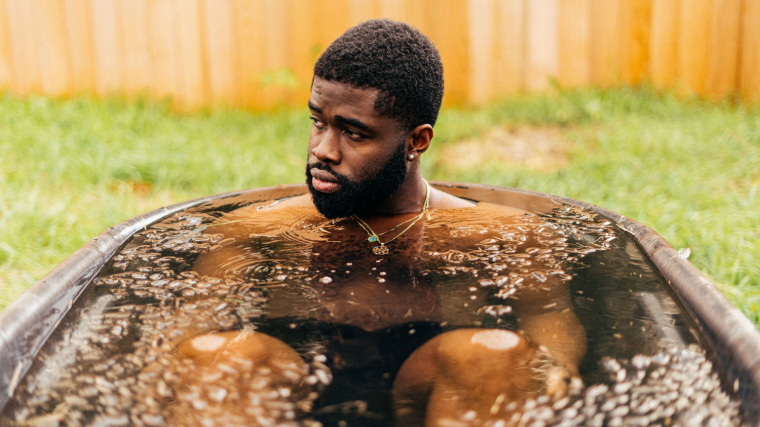
[Read More: The 10 Best Cold Plunge Tubs]
This process may increase blood flow deep in your vascular system, delivering oxygen and nutrients to deep tissues and muscles. Your body’s response to the cold shock peaks at 30 seconds and adapts after about two minutes. (8)(10)
Benefits of the Cold Plunge
Like sauna use, repeated cold exposure is a form of hormetic stress that may have health benefits. For athletes, following a cold plunge routine may help improve muscle recovery by reducing inflammation and muscle soreness. Let’s plunge into the research.
May Improve Muscle Recovery
Multiple studies suggest cold water immersion (CWI) positively affects muscle recovery. A systematic review of meta-analyses on the impact of recovery strategies on delayed-onset muscle soreness (DOMS), inflammation, muscle damage, and fatigue lists several instances where cold water immersion (CWI) may be beneficial. (11)
CWI seems to reduce inflammation and muscle damage after exercise. Vasoconstriction may reduce lactic acid buildup and diminish the inflammatory response in your muscles, potentially reducing the feeling of pain and soreness after training. (11)
In one meta-analysis, soccer players and basketball players had reduced fatigue after training and performing CWI. Their reduced perception of fatigue lasted 96 hours after their tournaments. (11)
[Read More: The Cold Hard Truths About Ice Baths and Muscle Recovery]
Another meta-analysis suggested CWI reduced DOMS in trained and untrained athletes after strenuous exercise. They found the optimal temperature and length of time was 11 to 15 degrees Celcius (about 51 to 59 degrees Fahrenheit) for 11 to 15 minutes. (11)
Additionally, a 2017 study on mixed martial arts fighters found that CWI after training reduced inflammation, muscle soreness, and fatigue. (12)
May Boost Cardiovascular Health
Research shows cold exposure, even through (less) cold water swimming, can positively affect cardiovascular health and reduce the risk of cardiovascular disease. CWI has been shown to lower blood pressure and cholesterol levels. In some studies, it also improved insulin resistance. (8)
May Strengthen Immune System
Some evidence suggests that a cold plunge can help strengthen your immune system. In a study on an ice swimmer, a blood test was done before and after a cold plunge at 6 degrees Celcius (42.8 degrees Fahrenheit). After the cold plunge, leukocytes, or white blood cells, increased significantly. (8)
Other studies also show increased white blood cells after a cold plunge. Researchers theorize that due to the stress of the cold shock, the immune system releases white blood cells to fight off the threat. Repeated cold exposure could increase white blood cells and boost your immune system over time, but more research is needed. (8)
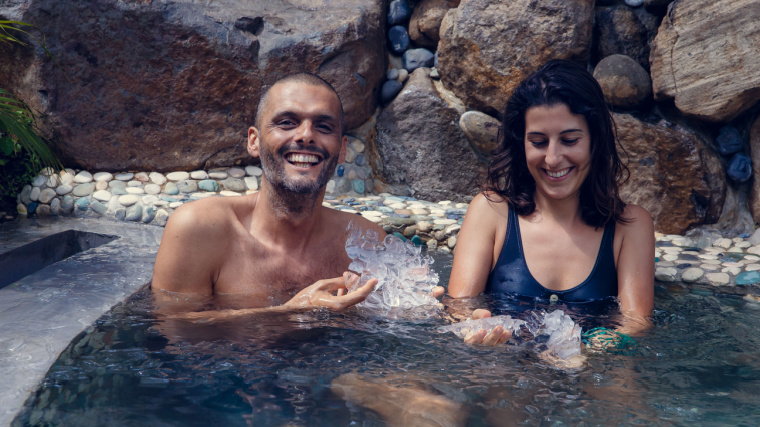
[Read More: How to Make Yourself a DIY Cold Plunge]
Another study combined cold exposure with breathwork and meditation to investigate its impact on the immune system. After combining the three techniques, people in the study were exposed to a bacterial infection. The group who practiced them had fewer symptoms. However, breathing may have been more significant than the cold exposure on immune system strengthening. (13)
May Improve Mental Health
Cold water immersion may help improve mental health and treat symptoms of depression.
The cold shock causes your body to produce the fight-or-flight hormone catecholamines. This activates your sympathetic nervous system and increases norepinephrine, adrenaline, and endorphins. The release of endorphins can increase energy levels and improve well-being. Repeated cold exposure may help treat depression over time. (8)
A case study was done on a 24-year-old cis woman with severe depression and anxiety. She had not responded to anti-depressant medications, including Fluoxetine and Citalopram. After stopping medication (under the supervision of her doctor), she began weekly cold water immersion. Her mood improved each time, and after a year, her depression symptoms were reduced. (8)
[Read More: Should You Cold Plunge Before or After a Workout?]
Other studies showed that regular cold water immersion improved general well-being in people with fibromyalgia, rheumatism, and asthma. (8)
It’s important to talk to a mental health professional if you experience depression, but a regular cold plunge may be a helpful addition to your treatment plan.
Differences Between the Sauna and Cold Plunge
So, what’s the difference between the sauna and the cold plunge?
- Heat Therapy Vs. Cold Therapy: Both expose you to extreme temperatures, putting your body under hormetic stress. The cold plunge is cold therapy, while the sauna is heat therapy.
- Length of Time: A cold plunge can be as short as five minutes and not longer than 15 minutes. Depending on the type of sauna, you stay in from five to up to 30 minutes.
- Vasodilation Vs. Vasoconstriction: Sauna bathing increases vasodilation, the relaxing of blood vessels. A cold plunge initially increases vasoconstriction, the constricting of blood vessels. Both can increase blood flow after a few minutes.
- Relaxation Vs. Building Mental Toughness: Although sitting in a hot sauna may be uncomfortable for some people, it may be relaxing, and you can stay in and breathe for a while. The cold plunge is not relaxing, but tolerating the cold builds mental toughness. It does cause a release of endorphins, so you may still feel “good” once it’s over.
How to Use the Cold Plunge
Here are some tips for the cold plunge.
- Time and Temperature: Research shows athletes can benefit from taking a cold plunge in water at 10 to 15 degrees Celcius for five to 15 minutes. (9)
- The Tub: You can get your own cold plunge tub or ice bath or use one at a facility.
- Start Slow: Starting slow is best if you’re new to the cold plunge. Try less cold water for a shorter time to build up your tolerance. You can also immerse just your feet and work up to immersing your full body.
- The Full Plunge: In its final form, you will fully immerse yourself in the cold water up to your neck.
- Warm Up After: After your cold plunge, warm up with a hot water shower, towels, or warm clothing.
- Consult Your Healthcare Provider: Check with your doctor before taking the cold plunge. Cold water immersion can be intense on your lungs. If you have any medical conditions, get the go-ahead before you jump in.
- Bonus Tip: Some people like to practice the Nordic cycle, or contrast therapy, which involves alternating immersion in cold and hot water.
How to Use the Sauna
Here are things to keep in mind for sauna use.
- Infrared Sauna Temperature and Time: For an infrared sauna, set the temperature to 40 to 60 degrees Celcius (104 to 140 degrees Fahrenheit) and stay for 15 to 30 minutes.
- Traditional Sauna Temperature and Time: In a traditional sauna, set the temperature to 70 to 100 degrees Celcius (158 to 212 degrees Fahrenheit) and stay for five to 20 minutes.
- Start Slow: If you’re new to sauna bathing, start with a short session to judge how your body reacts to heat. Gradually increase your length of time as you build a tolerance to heat.
- Stay Hydrated: Sweating in the sauna causes water and salt loss. Drink plenty of water before and after your sauna session to replenish your fluids.
- Consult Your Healthcare Provider: Before using the sauna, check with a doctor, especially if you are pregnant or have other medical conditions.
To Sweat or to Shiver?
Both the sauna and the cold plunge can significantly improve your recovery routine. Research shows that both may help improve muscle recovery by reducing muscle soreness and inflammation. Both may also benefit your cardiovascular health. The cold plunge can also boost your immune system and improve mental health.
The sauna is a more relaxing place to unwind after a workout. The cold plunge is intense and less comfortable but sends a release of endorphins to boost your mood and build mental toughness over time. Repeated exposure to both extreme temperatures will help your body adapt to that good stress.
FAQs
Here are some of the questions athletes ask most often when choosing their method of extreme temperature recovery.
It depends on which you prefer and what you can tolerate. You can also do both as a Nordic cycle of contrast therapy.
A cold plunge is a quick dip in ice-cold water (below 60 degrees Fahrenheit) for five to 15 minutes. A sauna is a hot and dry room where you stay for up to 30 minutes.
A sauna may cause temporary weight loss because you lose fluids during excessive sweating. Both can help improve muscle recovery if you’re doing cardio and resistance training as part of a weight loss program.
References
- Rhonda P. Patrick, Teresa L. Johnson, Sauna use as a lifestyle practice to extend healthspan, Experimental Gerontology, Volume 154, 2021, 111509, ISSN 0531-5565.
- Mero A, Tornberg J, Mäntykoski M, Puurtinen R. Effects of far-infrared sauna bathing on recovery from strength and endurance training sessions in men. Springerplus. 2015 Jul 7;4:321.
- Ahokas EK, Ihalainen JK, Hanstock HG, Savolainen E, Kyröläinen H. A post-exercise infrared sauna session improves recovery of neuromuscular performance and muscle soreness after resistance exercise training. Biol Sport. 2023 Jul;40(3):681-689.
- Masuda A, Miyata M, Kihara T, Minagoe S, Tei C. Repeated sauna therapy reduces urinary 8-epi-prostaglandin F(2alpha). Jpn Heart J. 2004 Mar;45(2):297-303.
- Laukkanen T, Khan H, Zaccardi F, Laukkanen JA. Association between sauna bathing and fatal cardiovascular and all-cause mortality events. JAMA Intern Med. 2015 Apr;175(4):542-8.
- Hussain J, Cohen M. Clinical Effects of Regular Dry Sauna Bathing: A Systematic Review. Evid Based Complement Alternat Med. 2018 Apr 24;2018:1857413.
- Soejima Y, Munemoto T, Masuda A, Uwatoko Y, Miyata M, Tei C. Effects of Waon therapy on chronic fatigue syndrome: a pilot study. Intern Med. 2015;54(3):333-8.
- Knechtle B, Waśkiewicz Z, Sousa CV, Hill L, Nikolaidis PT. Cold Water Swimming-Benefits and Risks: A Narrative Review. Int J Environ Res Public Health. 2020 Dec 2;17(23):8984.
- Versey NG, Halson SL, Dawson BT. Water immersion recovery for athletes: effect on exercise performance and practical recommendations. Sports Med. 2013 Nov;43(11):1101-30.
- Mooventhan A, Nivethitha L. Scientific evidence-based effects of hydrotherapy on various systems of the body. N Am J Med Sci. 2014 May;6(5):199-209.
- Dupuy, O., Douzi, W., Theurot, D., Bosquet, L., & Dugué, B. (2018). An Evidence-Based Approach for Choosing Post-exercise Recovery Techniques to Reduce Markers of Muscle Damage, Soreness, Fatigue, and Inflammation: A Systematic Review With Meta-Analysis. Frontiers in Physiology, 9, 312968.
- Lindsay A, Carr S, Cross S, Petersen C, Lewis JG, Gieseg SP. The physiological response to cold-water immersion following a mixed martial arts training session. Appl Physiol Nutr Metab. 2017 May;42(5):529-536.
- Kox M, van Eijk LT, Zwaag J, van den Wildenberg J, Sweep FC, van der Hoeven JG, Pickkers P. Voluntary activation of the sympathetic nervous system and attenuation of the innate immune response in humans. Proc Natl Acad Sci U S A. 2014 May 20;111(20):7379-84.
Featured Image: Mariusz Szczygiel / Shutterstock
The post Cold Plunge Vs. Sauna — Which is Better for Post-Workout Recovery? appeared first on BarBend.

